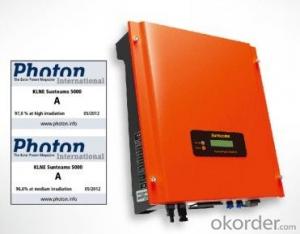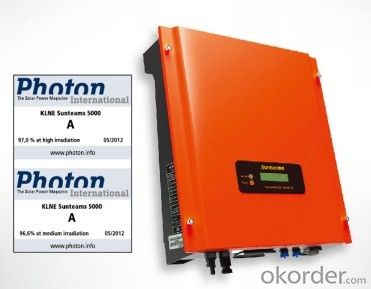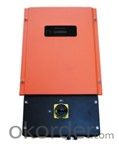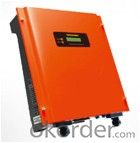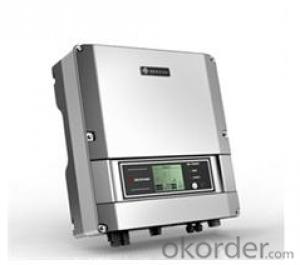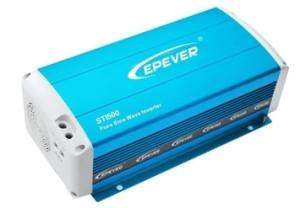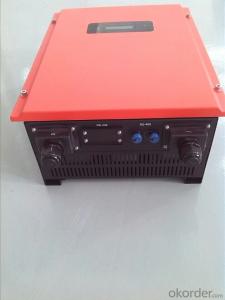Sunteams 1500 On Grid Solar Inverter with WiFi US Standard - India
- Loading Port:
- Shanghai
- Payment Terms:
- TT OR LC
- Min Order Qty:
- -
- Supply Capability:
- 10000 set/month
OKorder Service Pledge
Quality Product, Order Online Tracking, Timely Delivery
OKorder Financial Service
Credit Rating, Credit Services, Credit Purchasing
You Might Also Like
Sunteams 1500,2000,2500,3000,3600,4000,4600,5000
Sunteams US 1500,2000,2500,3000,3600,4000,4600,5000
1MPPT, single phase
IP 65
50Hz & 60 Hz
with Plug in wifi/ wifi box
with wire box/ without wire box
UL certified
■ For countries with UL certification (UL 1741 / IEEE 1547)
■ For countries with UL certification (UL 1741 / IEEE 1547)
Efficient
■ The CEC efficiency of the inverter can reach 95.0 %-97.5 %
■ Transformerless desi
■ The CEC efficiency of the inverter can reach 95.0 %-97.5 %
■ Transformerless desi
Simple
■ ‘Plug and play’connection for easy installation and maintenance
■ Designed for hanging with simple and easy installation
■ Fanless cooling concept
■ ‘Plug and play’connection for easy installation and maintenance
■ Designed for hanging with simple and easy installation
■ Fanless cooling concept
Communicative
■ RS232/RS485 interfaces as standard
■ Optional Bluetooth technology
■ RS232/RS485 interfaces as standard
■ Optional Bluetooth technology
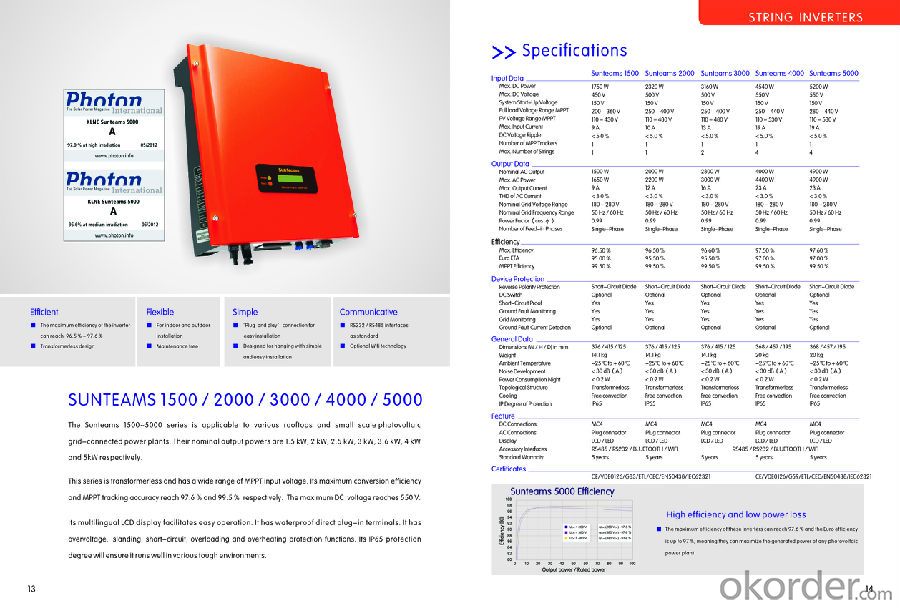
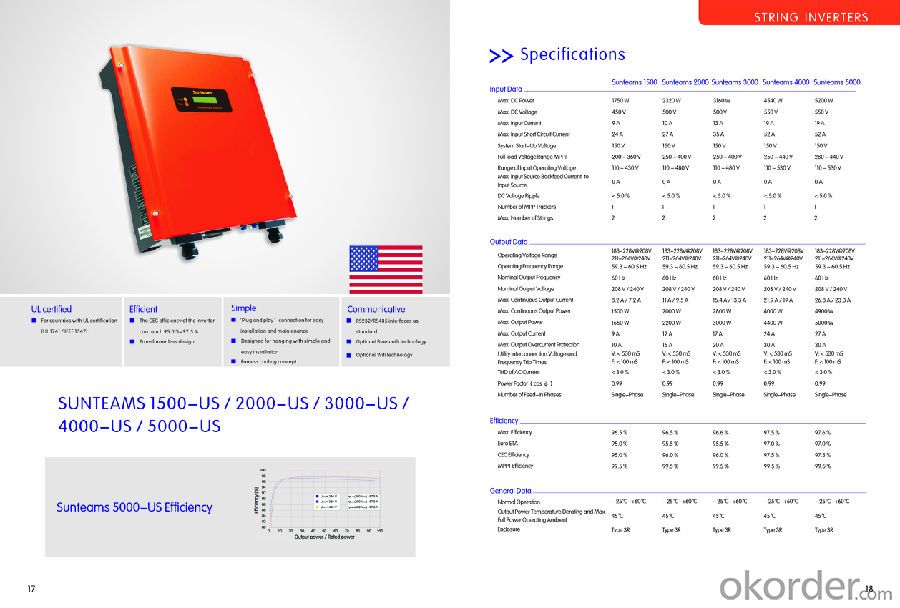

- Q: How does the input frequency range affect the performance of a solar inverter?
- The input frequency range directly affects the performance of a solar inverter. The inverter is designed to convert the variable direct current (DC) generated by the solar panels into stable alternating current (AC) that can be used by household appliances or fed into the grid. If the input frequency deviates from the specified range, it can lead to inefficient or unstable operation of the inverter. A wider input frequency range allows the inverter to handle fluctuations in the solar power generation, ensuring optimal performance and compatibility with different grid conditions.
- Q: Can a solar inverter be used with solar-powered water pumps?
- Yes, a solar inverter can be used with solar-powered water pumps. A solar inverter helps convert the DC power generated by solar panels into AC power, which is required to operate most water pumps. This enables the solar panels to generate electricity, which is then converted by the inverter to power the water pump, making it feasible to use solar energy to operate water pumps.
- Q: Can a solar inverter be used in a multi-string configuration?
- Yes, a solar inverter can be used in a multi-string configuration. In fact, many solar installations utilize multiple strings of solar panels connected to a single inverter. This allows for increased efficiency, flexibility, and the ability to harvest more energy from the sun.
- Q: How do you calculate the power output of a solar inverter?
- The power output of a solar inverter can be calculated by multiplying the DC voltage input from the solar panels by the DC current output. This will give you the DC power output. To calculate the AC power output, you need to consider the efficiency of the inverter. Multiply the DC power output by the inverter efficiency to determine the AC power output.
- Q: What is the role of a solar inverter in preventing system failures?
- The role of a solar inverter in preventing system failures is to convert the direct current (DC) produced by solar panels into alternating current (AC) that can be used by household appliances and sent back to the electrical grid. By ensuring that the DC power generated by the solar panels is properly converted and synchronized with the grid, the inverter helps maintain the stability and reliability of the entire solar power system. Additionally, the inverter monitors the voltage, frequency, and overall performance of the system, allowing it to detect and respond to any potential issues or faults that could lead to system failures.
- Q: What is the importance of insulation resistance measurement in a solar inverter?
- Insulation resistance measurement in a solar inverter is crucial as it helps ensure the safety and efficiency of the electrical system. By measuring the insulation resistance, any potential faults or deteriorations in the insulation can be detected, preventing electrical leakage or short circuits. This measurement also helps identify any insulation breakdowns that may compromise the performance and reliability of the solar inverter. Ultimately, insulation resistance measurement is essential for maintaining the integrity of the solar inverter and ensuring the safety of both the electrical system and the people using it.
- Q: How do you monitor the performance of a solar inverter?
- To monitor the performance of a solar inverter, several methods can be employed. Firstly, real-time monitoring systems can be installed that collect data on various parameters such as power output, voltage, current, and temperature. These systems often include data loggers or communication modules that transmit the information to a central monitoring station or cloud-based platform. Additionally, regular inspections and maintenance checks can be conducted to visually inspect the inverter for any signs of damage, loose connections, or overheating. Monitoring the inverter's efficiency over time, comparing the actual power output with the expected output based on solar irradiance and temperature, can also provide insights into its performance. Furthermore, some solar inverters come with built-in monitoring capabilities, allowing users to access performance data through a web-based interface or mobile app. This provides real-time and historical data, including energy production, system faults, and alerts, enabling users to identify and address any issues promptly. Overall, a combination of real-time monitoring systems, regular inspections, and utilizing inverter-specific monitoring features can effectively monitor the performance of a solar inverter.
- Q: Are solar inverters compatible with battery storage systems?
- Solar inverters and battery storage systems are indeed compatible. They play a vital role in combining solar power and battery storage. Solar inverters convert the DC electricity generated by solar panels into AC electricity, which can be used to power our homes and businesses. On the other hand, battery storage systems store excess solar energy for later use, enabling us to utilize solar power even when the sun is not shining. When paired with solar inverters, battery storage systems can be charged during the day using excess energy from the solar panels and then discharge that stored energy at night or during periods of high energy demand. To ensure compatibility, solar inverters used in battery storage systems come equipped with additional features and functionalities. For instance, they may have built-in charge controllers that regulate the charging and discharging of the batteries, ensuring optimal performance and longevity. Advanced inverters may also incorporate smart grid capabilities, allowing them to communicate with the utility grid and optimize energy flows based on grid conditions and electricity prices. All in all, solar inverters are vital components in seamlessly integrating battery storage systems with solar power. They enable us to maximize the advantages of clean and sustainable energy.
- Q: What are the key factors affecting the reliability of a solar inverter?
- The key factors affecting the reliability of a solar inverter include the quality and durability of its components, the overall design and engineering of the inverter, the operating conditions and environment in which it is installed, regular maintenance and servicing, and the manufacturer's reputation and track record for producing reliable products.
- Q: Can a solar inverter be used with different types of grounding materials?
- Yes, a solar inverter can be used with different types of grounding materials. Solar inverters are designed to be compatible with various grounding systems, such as ground rods, ground plates, and grounding grids. The choice of grounding material may depend on local regulations, soil conditions, and the specific requirements of the solar installation. However, it is important to ensure that the chosen grounding material meets the safety standards and provides proper electrical grounding for the solar system.
Send your message to us
Sunteams 1500 On Grid Solar Inverter with WiFi US Standard - India
- Loading Port:
- Shanghai
- Payment Terms:
- TT OR LC
- Min Order Qty:
- -
- Supply Capability:
- 10000 set/month
OKorder Service Pledge
Quality Product, Order Online Tracking, Timely Delivery
OKorder Financial Service
Credit Rating, Credit Services, Credit Purchasing
Similar products
Hot products
Hot Searches
Related keywords
